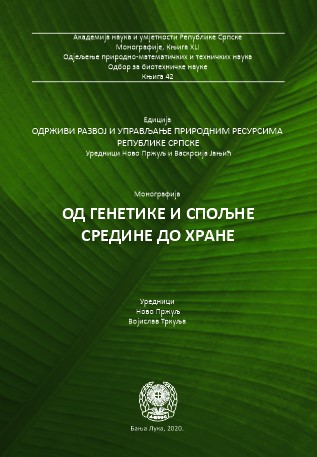Comparative genomics of cereals in an era of new sequencing technologies
DOI:
https://doi.org/10.7251/EORU2001181PKeywords:
Comparative genomics of cereals, wheat, barley, modern methods of DNA sequencing, molecular markersAbstract
Since ancient times, man has been observing not only diversities but also similarities that existed in the plant world. Similarities among certain species have long been predominantly used in the botanical systematisation. Thus, for instance, while studying the evolution of various plant and animal species, Darwin realised that there was a parallelism in the variation both within one species and between/among related species. According to many scientists and systematists, the similarity among plant species is inversely proportional to their evolutionary distance, and a greater distance means greater differences in traits of individual species. At the beginning of the 20th century, this regularity, even at the morphological level, was recognised and described by the Russian scientist Vavilov, calling it the law of homologous series. Studying collections of cultivated plants and their relatives from different parts of the world, Vavilov noticed that individual series of expressions of certain traits were regularly repeated in related species. Based on this regularity, this scientist could have predicted the existence of a trait in species in which it was as yet unknown. The observed differences and similarities at the morphological level have long been assumed to have their basis at the molecular level, in the genetic background/hereditary basis. At the end of the 20th century, the development of molecular biology led to the elucidation of the genetic code of the hereditary basis and provided establishing of a new scientific discipline, called comparative genomics. Comparative genetics is a science in which differences and similarities of related species are observed at the level of individual traits and genes that tends to explain traits from the evolutionary perspective and to determin to what extent the variation of individual traits is a result of orthologous genes, i.e. genes of the same origin. Comparative genomics is a scientific discipline in which similarities and differences in related species are studied not only at the level of individual genes, but at the level of the whole genome. It is considered that almost entire experimental biology will be, in the near future, based on hypotheses derived from comparisons of genes and genomes of related organisms, indicating the importance of comparative genetics and genomics. In practical sense, knowledge of homologous series in variation of traits within a species, between species and genera, that is knowledge of the laws of comparative genetics and genomics, is of great importance in breeding of plants with new traits. Cereal comparative genomics has been evolving for the past 25 years along side with the development of molecular genetics, providing better understanding of the evolution of cultivated species of the grass family, better comprehension of many important biological processes and invention of tools to be used in selection and breeding. Darwin's theoretical assumptions, especially of Vavilov's law of homologous series of variation, have come to full confirmation. Technological improvements in sequencing techniques have enabled decoding of genomes of many organisms, but also a complete application of laws of comparative genetics and genomics. On the other hand, the traditional approach to genetic and molecular studies has led to mapping and isolation of many different genes controlling regulating instead of controlling resistance to viruses and diseases, but also to important breeding traits in barley and wheat. Wholegenome sequencing of barley and wheat will in the near future provide efficient breeding for many traits at the allele level/for many allele-level traits, thus contributing to a broader genetic basis of all breeding-relevant traits in cereals. Comparative genomics will be extremely important, and it will play a special role in the isolation of important genes in cereals with large genomes in the vicinity of centromeres.
